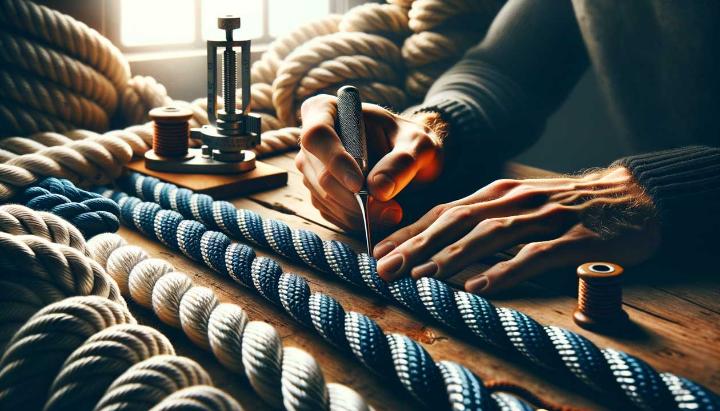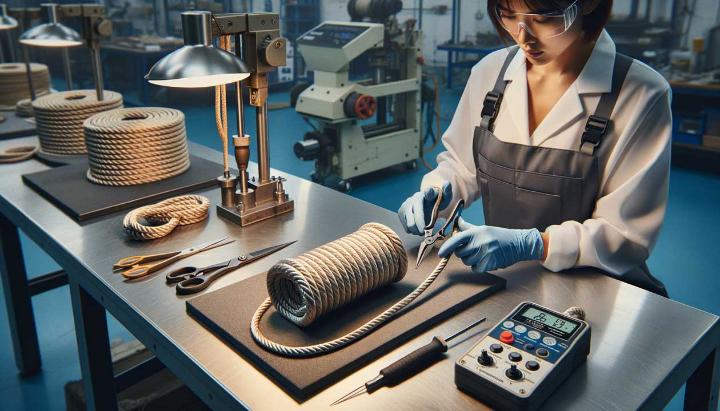Have you ever wondered why some ropes seem unbreakable, while others snap under the slightest pressure? The secret lies not just in the quality of the rope, but in the strength of its splices. At iRopes, we've mastered the art of creating high-strength rope splices that can withstand even the most demanding challenges. Our rigorous splice strength testing ensures that every connection we make is built to last.
In this guide, we'll unveil the essential rope making tools that are crucial for crafting superior splices. Whether you're an experienced rigger or a DIY enthusiast, understanding the right rope splicing tools and techniques can mean the difference between a secure connection and a potentially dangerous failure.
From the precision of a well-crafted rope splice tool to the finesse required in execution, we'll explore how these instruments contribute to creating splices that maintain up to 100% of a rope's original strength. Join us as we delve into the world of professional-grade rope splicing, and discover why the right tools and knowledge are indispensable for anyone serious about rope work.
Understanding the Rope Making Tool
Rope making is an ancient craft that has evolved significantly over time. Today, we have a variety of tools at our disposal to create strong, durable ropes for various applications. Let's dive into the fascinating world of rope making tools and explore how they can help you craft the perfect rope for your needs.
Components of a Rope Making Machine
A typical rope making tool consists of several key components that work together to transform fibres into a sturdy rope. Here's a breakdown of the main parts:
- Handle: The part you grip to operate the tool, allowing you to control the twisting motion.
- Spinning bar: This rotates to twist the fibres together, forming the basic structure of the rope.
- Crank mechanism: Connects the handle to the spinning bar, transferring your manual effort into the twisting motion.
- Guides: Help direct the fibres as they're being twisted, ensuring even distribution and tension.

How to Use a Rope Making Tool
Using a rope making tool might seem daunting at first, but with a bit of practice, you'll be crafting professional-quality ropes in no time. Here's a simple guide to get you started:
- Prepare your fibres by combing them out and aligning them parallel to each other.
- Attach the fibres to the hooks or clamps on your rope making tool.
- Begin turning the handle slowly, allowing the fibres to twist together evenly.
- As you continue turning, the fibres will form into yarns, then strands, and finally, a complete rope.
- Maintain consistent tension throughout the process for a uniform rope structure.
Remember, the key to creating a strong rope lies in the balance between twist and tension. Too much twist can weaken the rope, while too little won't provide enough strength. It's a skill that improves with practice, so don't be discouraged if your first attempts aren't perfect.
Pro tip: Start with natural fibres like cotton or hemp when learning to use a rope making tool. These materials are forgiving and allow you to get a feel for the process before moving on to more challenging synthetic fibres.
As you become more familiar with your rope making tool, you'll discover the joy of creating custom ropes tailored to your specific needs. Whether you're crafting ropes for sailing, climbing, or decorative purposes, understanding your rope making tool is the first step towards mastering this rewarding craft.
Mastering the Rope Splicing Tool: Essential Techniques
As we delve deeper into the world of rope making, it's crucial to understand the importance of rope splicing tools. These indispensable instruments are the key to creating strong, durable connections that can outperform even the most well-tied knots. Let's explore the essential techniques and tools that will elevate your rope splicing game.
Understanding the FID: The Ultimate Rope Splicing Tool
The FID, short for "Swedish Fid" or "Splicing Fid," is the unsung hero of rope splicing. This simple yet ingenious tool looks like a tapered needle and is essential for creating professional-grade splices. I remember the first time I held a FID – it felt like I'd been handed the key to unlocking a whole new level of rope craftsmanship.
- Versatility: FIDs come in various sizes to accommodate different rope diameters.
- Precision: The tapered design allows for accurate manipulation of rope fibres.
- Durability: High-quality FIDs are often made from stainless steel for long-lasting performance.
When choosing a FID, consider the size of the ropes you'll be working with most often. A good rule of thumb is to select a FID that's slightly smaller than the rope's diameter for easier insertion and manipulation.

Step-by-Step Guide to Splicing Double Braid Rope
Double braid rope, with its core and cover construction, is a popular choice for many applications due to its strength and flexibility. Here's a simplified guide to creating an eye splice in double braid rope:
- Mark your measurements on the rope, including the eye size and taper length.
- Using your FID, separate the core from the cover at the marked point.
- Taper the core by carefully removing strands over the measured length.
- Milk the cover back to expose more of the core.
- Insert the FID with the tapered core into the cover at the appropriate point.
- Carefully work the core back through the cover, ensuring it's not twisted.
- Smooth out the splice and adjust the eye size as needed.
- Secure the splice with a lock stitch for added strength.
Remember, practice makes perfect. Don't be discouraged if your first few attempts aren't flawless – even seasoned riggers had to start somewhere!
Safety first! Always wear protective gloves when splicing rope to prevent cuts and abrasions. Your hands will thank you later.
Mastering the art of rope splicing takes time and patience, but the results are worth it. A well-executed splice not only looks professional but also significantly increases the strength of your rope connections. As you continue to hone your skills, you'll find that splicing becomes an invaluable technique in your rope-working repertoire.
Have you tried your hand at rope splicing? What challenges did you face, and how did you overcome them? Share your experiences in the comments below – your insights could be incredibly helpful to fellow rope enthusiasts!
Achieving Superior Splice Strength with the Rope Splice Tool
As we delve deeper into the world of rope splicing, it's crucial to understand how a dedicated rope splice tool can elevate your splicing game. I've spent countless hours perfecting my splicing technique, and I can't stress enough the difference a quality splice tool makes. Let's explore how these tools can help you achieve superior splice strength that outperforms even the most well-tied knots.
Understanding the Superior Strength of Spliced Ropes
When I first learned about the strength retention of spliced ropes, I was astounded. Did you know that a properly spliced rope can retain up to 100% of its manufacturer-rated breaking load? This is a game-changer compared to knotted ropes, which can lose up to 50% of their strength at the knot.
- Strength retention: Spliced ropes maintain 85-100% of their original strength.
- Load distribution: Splices spread the load evenly across the rope fibres, reducing stress points.
- Durability: A well-executed splice can outlast the rope itself in many cases.
This superior strength makes spliced ropes the go-to choice for critical applications in marine, industrial, and outdoor adventure sectors. Imagine the peace of mind knowing your climbing rope or boat mooring line has near-full strength at its connection points!
Essential Tools for Professional Rope Splicing
To achieve these impressive results, you'll need the right tools in your kit. Here are the must-have items for any serious splicer:
- Fids: These tapered needles are the backbone of rope splicing, allowing you to weave rope strands with precision.
- Pushers: Essential for working with hollow-braid ropes, pushers help you manipulate the rope core.
- Loop pullers: These tools make creating uniform loops a breeze, especially in thicker ropes.
- Scissors or hot knife: For clean cuts and sealing synthetic rope ends to prevent fraying.

Investing in a quality professional rope splicing kit is worth every penny. Trust me, I learned this the hard way after struggling with makeshift tools in my early days!
Step-by-Step Guide to Creating Strong Splices
Now, let's walk through the process of creating a strong eye splice using a rope splice tool:
- Measure and mark your splice length, typically 72 times the rope diameter for a 12-strand braid.
- Unlay the rope strands carefully, maintaining their original twist.
- Use your fid to create a tunnel in the rope's core, starting at the marked point.
- Thread the working end through this tunnel, following the rope's natural lay.
- Taper the splice by removing strands progressively as you work back through the rope.
- Smooth out the splice, ensuring even tension throughout.
- Secure the splice with a lock stitch using a smaller diameter cordage.
Remember, practice makes perfect. Don't get discouraged if your first few splices aren't flawless – even seasoned riggers had to start somewhere!
Tips for Optimizing Splice Strength and Durability
To ensure your splices stand the test of time and maintain maximum strength:
- Maintain proper tension: Keep the rope taut but not overstretched during splicing.
- Follow the lay: Always work with the natural twist of the rope for smoother splices.
- Use the right tools: Match your splicing tools to the rope diameter for best results.
- Protect your splice: Consider using chafe guards in high-wear areas.
Pro tip: When splicing synthetic ropes, use a hot knife to seal the cut ends. This prevents fraying and makes threading through the rope much easier.
By following these guidelines and using the right tools, you'll be creating professional-grade splices in no time. Remember, the strength of your splice can mean the difference between success and failure in critical applications, so it's worth taking the time to master this essential skill. For example, understanding the testing of tensile strength in nylon ropes can help you achieve optimal results.
Have you tried your hand at rope splicing? What challenges did you face, and how did you overcome them? Share your experiences in the comments below – your insights could be incredibly valuable to fellow rope enthusiasts!
Enhancing Splice Performance: Tools and Techniques
As we delve deeper into the world of rope making and splicing, it's crucial to understand how proper tool selection and technique can dramatically improve splice performance. I've spent years honing my skills, and I can't stress enough how important it is to get these aspects right. Let's explore the key factors that can take your splicing game to the next level.
Selecting the Proper Splicing Tools
Choosing the right tools for your splicing tasks is like selecting the perfect ingredients for a gourmet meal - it can make or break the final result. Here are some essential tools you'll need in your splicing kit:
- Fids: These tapered needles come in various sizes and are crucial for weaving rope strands with precision.
- Splicing tape: This helps maintain the rope's shape during the splicing process.
- Sharp scissors or a hot knife: For clean cuts and sealing synthetic rope ends to prevent fraying.
- Measuring tape: Accuracy is key in splicing, and a good measuring tape ensures consistent results.
When I first started splicing, I made the mistake of using whatever tools I had on hand. Trust me, investing in quality tools specifically designed for splicing will save you time, frustration, and ultimately produce stronger, more reliable splices.

Mastering Splice Techniques for Optimal Results
Now that you've got the right tools, let's talk technique. Mastering these steps will help you achieve consistently strong splices:
- Measure and mark your splice carefully, following the rope manufacturer's recommendations.
- Prepare the rope ends meticulously, ensuring clean cuts and, for synthetic ropes, properly sealed ends.
- Follow the rope's natural lay when weaving strands to maintain its inherent strength.
- Maintain consistent tension throughout the splicing process for uniform strength.
- Taper your splice gradually to distribute load evenly and prevent weak points.
Remember, practice makes perfect. I spent countless hours perfecting my technique, and each splice taught me something new. Don't get discouraged if your first attempts aren't flawless - even the most experienced riggers started somewhere!
Common Mistakes to Avoid When Using Rope Splicing Tools
In my years of splicing, I've seen (and made) my fair share of mistakes. Here are some common pitfalls to watch out for:
- Using the wrong size fid: This can damage the rope or create an inconsistent splice.
- Overlooking rope preparation: Skipping proper cleaning and end sealing can lead to premature wear.
- Rushing the process: Splicing requires patience. Rushing often results in weak or sloppy splices.
- Ignoring the rope's natural lay: Working against the rope's structure weakens the splice significantly.
Safety first! Always wear protective gloves when splicing, especially with synthetic ropes. The fibers can be surprisingly sharp and cause nasty cuts if you're not careful.
By avoiding these mistakes and focusing on proper technique, you'll be well on your way to creating splices that are not only strong but also aesthetically pleasing. Learning about the proper use of nylon rope clamps can further enhance your splicing outcomes. Remember, a well-executed splice is a testament to your skill and attention to detail.
Have you encountered any challenges in your splicing journey? What techniques have you found most effective? Share your experiences in the comments below - your insights could be invaluable to fellow rope enthusiasts!
Unlock the Secrets to Strong Rope Splices with the Right Tools
Mastering rope splicing techniques is essential for creating strong, durable rope connections, and the right tools make all the difference. This guide explores the essential rope making tool, the versatile rope splicing tool, and the dedicated rope splice tool, offering detailed insights into each for achieving superior splice strength. By understanding tool selection, advanced splicing techniques, and common mistakes to avoid, you'll optimise your splicing results and ensure maximum durability. Don't miss out on these valuable tips to enhance your rope working skills. Please fill in the inquiry form above for more information.